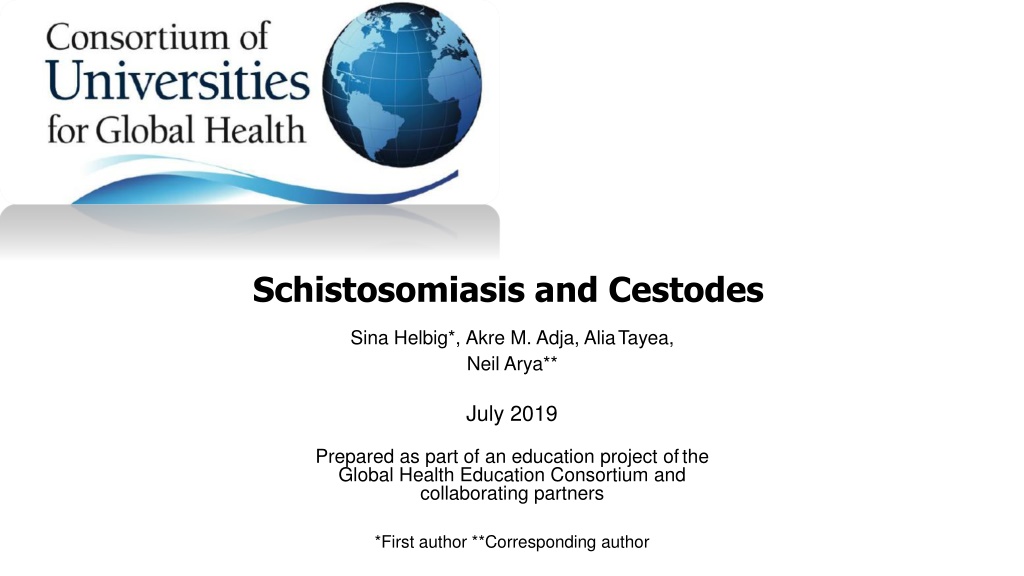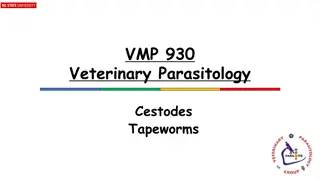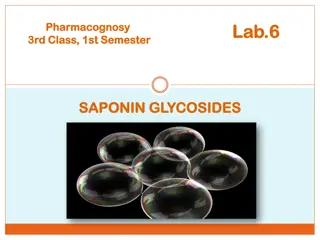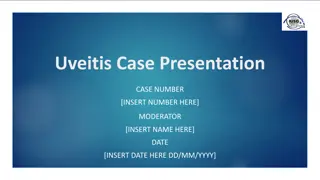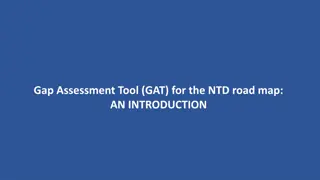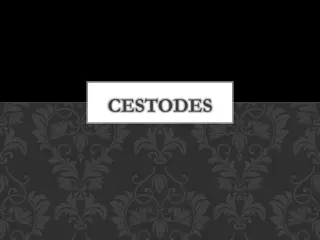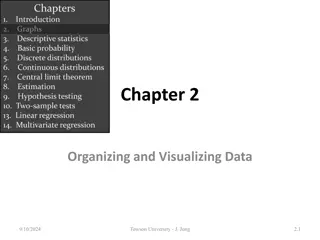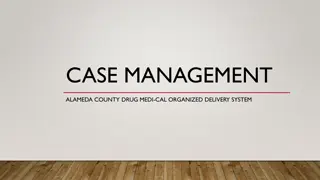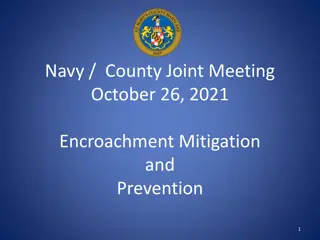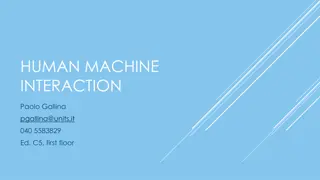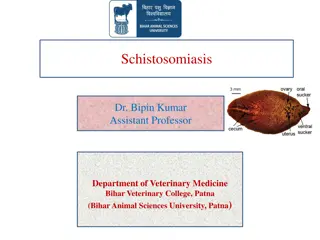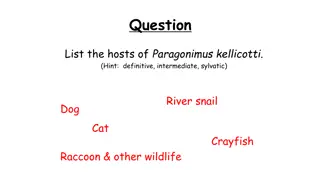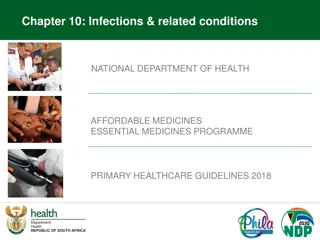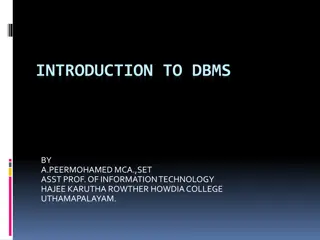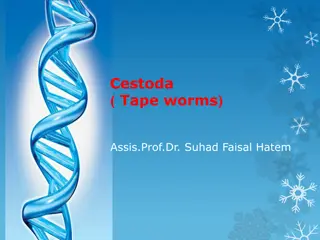Understanding Schistosomiasis and Cestodes: A Comprehensive Overview
Schistosomiasis, caused by Schistosoma parasites, is a significant public health concern in over 70 countries, affecting millions of people worldwide. The disease has high morbidity and can lead to indirect deaths, particularly in Africa. Risk factors include poor sanitation practices and exposure to contaminated water sources. The infection intensity typically decreases with age due to acquired immunity. Schistosomiasis impacts not only individual health but also socioeconomics, affecting productivity and causing financial burdens on affected families.
Download Presentation

Please find below an Image/Link to download the presentation.
The content on the website is provided AS IS for your information and personal use only. It may not be sold, licensed, or shared on other websites without obtaining consent from the author. Download presentation by click this link. If you encounter any issues during the download, it is possible that the publisher has removed the file from their server.
E N D
Presentation Transcript
Schistosomiasis and Cestodes Sina Helbig*, Akre M. Adja, AliaTayea, Neil Arya** July 2019 Prepared as part of an education project ofthe Global Health Education Consortium and collaborating partners *First author **Corresponding author
INDEX: Schistosomiasis and Cestodes Schistosomiasis (S. mansoni / japonicum / mekongi) --------- (9.1 -- 9.7) Neurocysticercosis --------------------------------------------------- (10.1 -- 10.7)
Schistosomiasis (Bilharzia, Snail fever) Trematode (Fluke) Sina Helbig*, Alia Tayea, Akre M. Adja, Neil Arya** Prepared as part of an education project ofthe Global Health Education Consortium and collaborating partners *First author **Corresponding author
9.1 Epidemiology Parasitic helminth endemic to >70 countries o At least 240 million people affected, and 700 million at risk o Annual deaths from schistosomiasis difficult to estimate: disease can kill directly & indirectly (e.g. associated carcinomas) o Revised estimates put death toll from disease at over 200,000/yr, mostly in Africa In endemic areas usually acquired in childhood o Infection increases in prevalence with age o Peak age 15-20 years old o Risk is related to occupation and exposure routes Page4
9.1 Epidemiology Infection intensity decreases with age o Acquired immunity, change in water contact, change in egg production by worms Although relatively low (direct) case - fatality ratio, disease has extremely high morbidity and enormous impacts on health and socioeconomics o Decreased productivity in chronic disease o Associated impacts on families of those affected, in the form of treatment costs and loss of income Two main types of disease: Urinary and Intestinal Page5
9.2 Risk factors Poor sanitation practices o Excretion of eggs into water sources used for drinking, bathing, domestic use, etc. School-age children (less immunity) Fresh-water exposure by swimming or bathing in water containing infectious cercariae Occupational exposure through e.g. irrigation ditches, rice farming, etc. o Particularly in/near standing or slow-moving water, where the snail hosts can attach to vegetation Page6
9.3 Biology Eggs of S. mansoni showing lateral spine Photo credit: WHO-TDR-Pasteur Inst Page7
9.3 Biology Egg of S. haematobium, showing terminal spine Photo credit:WHO-TDR-Stammers Page8
9.3 Biology Egg of S. japonicum, with vestigial spine (arrow). The eggs are smaller than those of S. haematobium or S. mansoni and are oval or subspherical Photo credit:CDC Page9
9.3 Life cycle * Different snails act as intermediate hosts for different species of Schistosoma. Page10
9.4 Symptoms (general) Two syndromes typically seen o Early/Acute Cercarial dermatitis, swimmer sitch Katayama fever/Katayama syndrome o Chronic disease (various manifestations) o Pathogenesis primarily through cell mediated immunity Egg granuloma formation leads to fibrosis Cercarial dermatitis o Result of penetration of cercariae through skin o Commonly with S. hematobium, S. mansoni o Pruritis, papular rash at the site of cercarial penetration o Occurs mostly within 24h of exposure, but reports range from minutes up to 1 week Page11
9.4 Symptoms- Acute disease Acute schistosomiasis- Katayama fever/syndrome o Early clinical manifestation with 1st infection or heavy reinfection (primarily S. japonicum/mansoni) o More likely in traveler or new immigrant to endemic region o Symptoms 4-8 weeks after exposure with beginning of egg depositionin tissue o Non-specific symptoms: fever, sweat, chills, cough, diarrhea,headaches o Lymphadenopathy o Hepatosplenomegaly o Urticaria o Respiratory symptoms interstitial pneumonitis (more commonly seenin S. haematobium) o Eosinophilia, hyperglobulinemia o Immune complex reaction = Serum sickness Page12
9.4 Symptoms - Chronic Disease Chronic intestinal disease o S. mansoni, S. japonicum, S. mekongi o Eggs in the intestinal wall Inflammation Microabscesses Polyposis o Symptoms Diarrhea commonly in children Left lower quadrant pain Occult or visible blood in stool Polyposis protein-losing enteropathy Severe colonic obstruction Abdominal distention/ascites S. mansoni http://www.path.cam.ac.uk/~schisto/schistosoma/S.ma nsoni.egg.gif Page13
9.4 Symptoms - Chronic Disease Chronic hepatic disease o S. mansoni, S. japonicum o Eggs embolize to liver o Granulomatous inflammatory reaction (hepatomegaly) Presinusoidal inflammation, periportal fibrosis Clay-pipe-stem fibrosis o Periportal collagen deposits Obstruction of blood flow portal hypertension varices, splenomegaly/hypersplenism S. japonicum Photo:http://www.path.cam.ac.uk/~schist o/helminth_eggs/S.japonicum.egg.gif Page14
9.4 Symptoms - Chronic Disease Chronic cardiopulmonary/pulmonary disease o Cardiopulmonary hypertension o Associated with hepatosplenic disease Presinusoidal portal hypertension portocaval shunts eggs travel and lodge in pulmonary vasculature o Pulmonary hypertension: antiparasitic treatment = no effect Chronic CNS disease o S. japonicum brain lesions (seizures) o S. mansoni spinal cord lesions (more likely to be symptomatic, transverse myelitis) o Ectopic worm or egg dissemination (egg embolizes) o Diagnosis usually difficult, since rarely systemic symptoms Page15
9.4 Symptoms - Chronic Disease Chronic urinary tract disease o Usually in children o Egg deposits in distal ureter and bladder wall o Hematuria 10-12 weeks after exposure o Dysuria o Late manifestations: Nephrotic range proteinuria Bladder calcifications Ureteral obstruction Renal colic Renal failure Secondary bacterial infections Bladder carcinoma (squamous cell well differentiated with local spread; accounts for up to 31% of all cancers inEgypt) Public health impact of schistosomiasis: disease and mortality. WHO Expert Committee on the Control of Schistosomiasis Bull World Health Organ 1993,71(6):657-662. Page16
9.4 Symptoms - Chronic Disease Chronic urogenital disease/ female genital schistosomiasis o Genital schistosomiasis is relatively common in communities where women are exposed to S. haematobium through domestic work in infested waters. o Female genital schistosomiasis can be present without any urinary manifestations of S. haematobium and can mimic other gynaecological conditions. o Bleeding, abdominal pain, ectopic pregnancies o Association with increased risk of acquiring HIV and otherSTD s Photo: http://www.dpd.cdc.gov/dpdx/IMAGES/ParasiteImages/S- Z/Schistosomiasis/S_haematobium_egg_HB2.jpg * Female genital schistosomiasis as an evidence of a neglected cause for reproductive ill-health: a retrospective histopathological study from Tanzania BMC Infectious Diseases 2006, 6:134 doi:10.1186/1471-2334-6-134 http://apps.who.int/iris/bitstream/handle/10665/180863/9789241509299_eng.pdf;jsessionid=A709E0CE27A591D302C4ED5B0C774041?sequence=1 Page17
9.5 Diagnosis Gold Standard: Eggs in stool of patient Intestinal and hepatic schistosomiasis o Eggs identified in tissue of patient (liver/intestinal biopsy) o Serology: FAST ELISA No distinction between past and currentinfection Useful if negative rule out Useful in travelers Urinary schistosomiasis o Eggs in urine or on bladder biopsy o FAST ELISA o After diagnosis: evaluation of ureters, squamous cell carcinoma Page18
9.6 Treatment Praziquantel o All species o Works against adult worms o Cure rate 60-90% o Exact mechanism of action unknown o Causes tetanic contraction and paralyzes adult worm o Sequestered antigens get exposed, which facilitates host immune destruction Treatment of complications of schistosomiasis, e.g. cancers, intestinal disease Photo:http://www.panzyma.com/servicios/perfi l/img-catalogos/praziquantel.jpg Page19
9.7 Control Ecological approaches for snail control o Shown to be successful in Japan, where S. japonicum largely eliminated from islands; considered eradicated since 1976 o E.g. current speed of rivers, streams, etc. This has significant effect on snail host density Community-based control measures o Public health education on disease & infection routes o Improved sanitation and sanitation practices No urination/ defaecation in water sources! o Mass chemotherapy (praziquantel) Page20
Other Liver Flukes and Lung Flukes Liver Flukes: o Clonorchis sinensis o Opisthorchis felineous o Fasciola hepatica Lung Flukes: o Paragonimus spp. Fasciola hepatica Photo:http://upload.wikimedia.org/wikipedia/commons/thumb/3/35/Fasciol a_hepatica2.jpg/250px-Fasciola_hepatica2.jpg Page21
Neurocysticercosis Sina Helbig*, Alia Tayea, Akre M. Adja, Neil Arya** Prepared as part of an education project of the Global Health Education Consortium and collaborating partners *First author **Corresponding author
10.1 Epidemiology Infection of the CNS by larval form of pork tapeworm (Taenia solium) Estimated 50 million affected worldwide, with 50,000 deaths resulting from the condition Prevalence greatly reduced in Western Europe, where prevalence used to be close to the current prevalence in Mexico (1.9%) o Remains common in most developing countries A major cause of epilepsy in developing countries o Main cause of acquired epilepsy Page23
10.1 Epidemiology Photo: http://www.who.int/zoonoses/diseases/approximate%20global%20distribution%20of%20cysticercosis.jpg Page24
10.2 Risk factors Ingestion of parasite eggs, larvae by any route along the fecal-oral transmission pathway Poor hygiene practices (esp. handwashing) of infected people, as T. solium eggs excreted in feces During food preparation, handling Autoinfection However, infection with parasite does not mean person will develop neurocysticercosis o Not all persons with taeniasis have CNS involvement Vegetarians equally at risk if they are exposed to person excreting eggs! *Eating undercooked meat only leads to T. Solium infection which is asymptomatic for this person, excreted eggs in feaces of this person are infectious and causes NCC. Page25
10.3 Life cycle o Only if eggs are ingested by human can they cause neurocysticercosis o Ingested taenia eggs are activated by gastric and duodenal environment develop into invasive larvae (oncospheres) in the small intestine migrate across the intestinal wall carried by bloodstream where they eventually settle and mature into cysticerci (process duration up to 2m) o Tropism for soft tissue, muscle and CNS; Cysts can be up to 1cm large. Largest in the ventricles/ subarachnoid space, smaller in brain parenchyma o Little immune response elicited by established cysticerci If they are not actively growing or degenerating Page26
10.4 Symptoms Majority of cases are asymptomatic, and can remain so for decades o Little immunological reaction from intact cysticercallarvae; more serious reactions to dying, degenerating cysticerci Leads to seizures, headaches (common) and stroke Cases with many lesions and brisk inflammatory response (particularly with degenerating cysts): sub- acute encephalitis If space-occupying lesion: any focal symptomatology including weakness and extrapyramidal symptoms Page27
10.4 Symptoms Ventricular disease: 15% of cases, obstructive hydrocephalus o May spontaneously remit due to ball-valve effect upon motion intermittently occluding the ventricular outlet foramina o Untreated, most cases progress to sustained hydrocephalus Spinal disease: cysts in and around the cord have been reported o Progressive paraplegia developing over period of weeks Changes in mental status, cognitive impairment, psychiatric disease, balance problems Ocular disease: cysts subretinal or intravitreous Page28
10.5 Diagnosis Cysts on neuroimaging o CT (better at diagnosing calcified lesions) o MRI (better at diagnosing cysts) Spinal disease per myelography Photo:http://img.medscape.com/pi/eme d/ckb/neurology/1134815-1168784- 418tn.jpg Serology: o ELISA sensitivity > 90% - crossreactivity with other helminths o Detection of Ab or Ag in CSF Page29
10.5 Diagnosis Neurocysticercosis in the brain (Photo credit: WHO/AL Willingham) from http://www.who.int/zoonoses/neglected_zoonotic_disea ses/en/ Tapeworms in the human intestine can grow to over 3m in length (Photo credit: http://mtherald.com/images/tapeworm.jpg) Page30
10.6 Treatment Treatment is complex and treatment plan controversial Some advocate only treating certain cases due to the adverse reactions associated with immune reaction to dying parasite o Most viable cystic lesions either calcify or disappear, in viable lesions antihelminthic therapy may hasten the death of parasite, but not change clinical outcome o Advocate treating with corticosteroids and anti-epileptic drugs, optimal duration is subject to debate Medications o Praziquantel o Albendazole Page31
10.6 Treatment Always pre-treat with corticosteroids, and continue during treatment o Decreases inflammatory reaction elicited by dyingcysticerci Surgical treatment only in selected cases of ventricular cysts, eye involvement Shunt placement in case of hydrocephalus Page32
10.7 Control Avoid contact with pig faeces, either direct or indirect (e.g. occupational exposures) Thorough cooking of pork meat Cooking/peel fruits and vegetables that may have come into contact with pig feaces (e.g. during cultivation) Avoid drinking from water sources that may be contaminated by pig faeces Washing hands after using toilet and before food handling Potentially, vaccination of pigs (current vaccine available (WHO 2018)) http://www.who.int/en/news-room/fact-sheets/detail/taeniasis-cysticercosis https://www.galvmed.org/news/first-ever-licenced-vaccine-major-cause-epilepsy-developing-world/ Page33
Acknowledgments Thanks to Jenna Kelly, Shazeen Bandukwala, Melissa Whaling, and Josephine Esposto for critical editing. We appreciate Tim Brewer and Jackeline Alger for thoughtful review. Page34
Credits Akre M. Adja1, Sina Helbig2, Alia Tayea3, Neil Arya4 1: Institut Pierre Richet, Universit de CocodyAbidjan 2: Boston University School of Medicine, Division of Infectious Diseases, Boston, MA, USA 3: M decins Sans Fronti res 4: Western University, University ofWaterloo, McMaster University Contact narya@uwaterloo.ca
